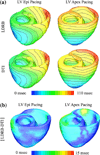A novel rule-based algorithm for assigning myocardial fiber orientation to computational heart models
- PMID: 22648575
- PMCID: PMC3518842
- DOI: 10.1007/s10439-012-0593-5
A novel rule-based algorithm for assigning myocardial fiber orientation to computational heart models
Abstract
Electrical waves traveling throughout the myocardium elicit muscle contractions responsible for pumping blood throughout the body. The shape and direction of these waves depend on the spatial arrangement of ventricular myocytes, termed fiber orientation. In computational studies simulating electrical wave propagation or mechanical contraction in the heart, accurately representing fiber orientation is critical so that model predictions corroborate with experimental data. Typically, fiber orientation is assigned to heart models based on Diffusion Tensor Imaging (DTI) data, yet few alternative methodologies exist if DTI data is noisy or absent. Here we present a novel Laplace-Dirichlet Rule-Based (LDRB) algorithm to perform this task with speed, precision, and high usability. We demonstrate the application of the LDRB algorithm in an image-based computational model of the canine ventricles. Simulations of electrical activation in this model are compared to those in the same geometrical model but with DTI-derived fiber orientation. The results demonstrate that activation patterns from simulations with LDRB and DTI-derived fiber orientations are nearly indistinguishable, with relative differences ≤6%, absolute mean differences in activation times ≤3.15 ms, and positive correlations ≥0.99. These results convincingly show that the LDRB algorithm is a robust alternative to DTI for assigning fiber orientation to computational heart models.
Figures






References
-
- Alexander AL, Hasan KM, Lazar M, Tsuruda JS, Parker DL. Analysis of partial volume effects in diffusion-tensor MRI. Magn. Reson. Med. 2001;45(5):770–780. - PubMed
-
- Bayer JD, Beaumont J, Krol A. Laplace–Dirichlet energy field specification for deformable models. An FEM approach to active contour fitting. Ann. Biomed. Eng. 2005;33(9):1175–1186. - PubMed
-
- Beyar R, Sideman S. A computer study of the left ventricular performance based on fiber structure, sarcomere dynamics, and transmural electrical propagation velocity. Circ. Res. 1984;55(3):358–375. - PubMed
Publication types
MeSH terms
Grants and funding
LinkOut - more resources
Full Text Sources
Other Literature Sources

